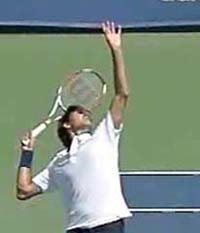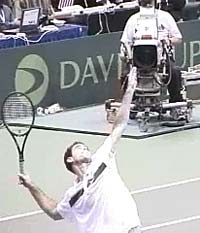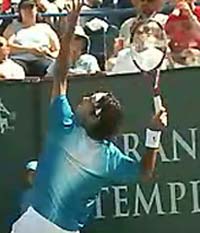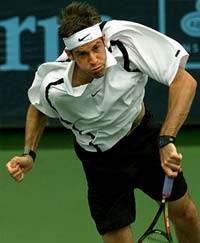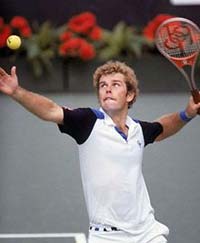|
TennisOne Lessons What Makes Roger Federer's Serve Great? Paul Fein Seven centuries after legendary Swiss patriot William Tell, an expert marksman with the crossbow, redeemed his life by shooting an apple off the head of his son in a single attempt, Roger Federer repeated the feat with a tennis ball. For a Gillette razor TV commercial, equally nerveless Federer, dressed in a sports jacket, twice knocked a can off a crew member’s head with a serve. We know The Amazing Fed has every shot in the book and then some, but uncanny accuracy is just one of the strengths of his superb serve. Pat Cash, the 1987 Wimbledon champion and authoritative BBC commentator, analyzes in depth and detail the serve of this modern-day Swiss legend.
Like most of Federer’s shots, his serve is unique and not what I regard as perfect technique. His greatest asset is his consistency of technique; every serve is the same no matter what the score is in the match. If you want to break down the serve piece by piece, you will find several things the greatest servers in the history of the game—such as Ivanisevic, Sampras, Krajicek, Roddick, Rusedski, and even Roscoe Tanner—do that Federer does not. However, what Federer lacks in technique, he makes up for with talent. Body Weight Transfer Federer has a perfect knee bend. If he had a bigger knee bend, he would have problems because he would be jumping directly up and not coming underneath the ball. As I mentioned earlier, he needs to have the perfect ball toss. Tossing arm
Federer releases the ball at head height. His tossing arm has a long follow-through, much like Sampras, Navratilova and Serena. A long follow-through for the tossing arm can be good or bad. Keeping the left arm up produces a bowing or bending of the left side of the body as the hitting arm comes forward. Keeping the left arm up too long can hinder a player if you don’t get the arm back down quickly enough, you end up with your head and your arm up in the air. Regardless of how high the tossing arm goes up, the main thing is that it comes down quickly. Ivanisevic and Rusedski and Tanner didn’t have their tossing arms up as high. It’s just as important to get the left side through as it is the right side through on the serve. The left side has to go down and around to enable the right side to come through. Some of these players do break the mold. Roddick is the classic case; he gets his tossing arm way up but gets it down with lightning speed, and Federer is another player. With Sampras, because the timing is so good and the rhythm so smooth and consistent, that even if his tossing arm is not typical for a great server, he manages to overcome that with his natural physical ability and his racquet head speed. Arm bend Over the years Federer’s elbow bend has become more and more pronounced. In fact, he almost hits his head with his racquet. This is very extreme, and I would never teach this to a young player. In my opinion, Sampras and Krajicek have the perfect 80-90 degree elbow bend.
Swing Speed Federer’s timing is perfect, the motion is seamless and his rhythm is very consistent, almost machine-like, which gives him great confidence his serve will go in. One of Federer’s assets is his ability to generate great racquet head speed on all his shots. He has a very fast arm whether it’s a 210 kmph (130 mph) first serve or a second serve with spin. Because his timing is so good, he can really do anything with the serve—anytime. That always keeps his opponent guessing. Summary Federer’s favorite serve is the serve down the middle in the ad court. His weakest serve, under pressure, is his wide serve to the ad court. Some opponents, such as Nadal, Djokovic and Murray, look for his serve up the middle on big points. Federer’s second serve is usually accurate and while not as dangerous as Roddick’s spin serve, he can add extra spin if he needs to. Tactically, Federer’s serve is one of the best ever. His second serve is never under pressure as the players in this era do not attack as Sampras, Becker, Rafter, or McEnroe did. This would be my No. 1 surprise tactic against him and all the top 10 players, and I believe it would be successful. Roddick, Del Potro, Isner, Karlovic, and young gun Raonic are better servers, but Federer’s consistency day after day is amazing.
Criteria (Rating) Power (8) His power comes from racquet head speed, great timing, weight transfer, a highly coordinated motion and hitting the ball in the center of the strings. As a result, he always hits the ball cleanly. It’s quite incredible, actually. Command of Different Spins (9.5) Federer is one of the all-time greats at using his spin tactically, just as he is at using his accuracy tactically. He doesn’t serve with as much spin as Roddick does, but he uses spin incredibly well. Federer possesses all the serves, and one of his best spin serves is a wicked slice out wide in the deuce court, which he uses very effectively, especially against Nadal. He doesn’t have the height of [6’5”] Krajicek or [6’4”] Ivanisevic, so his kick serve doesn’t bounce quite as high, but he can slice the ball quite slowly and let the ball just fade away from his opponent. He can kick serve the ball down the middle and his spin second serves are very effective. He doesn’t use the slice body serve as well as he could, especially on grass, but he’s [still] won Wimbledon six times. (Laughter) Depth (9) His depth is generally very good, although it can drop short on the second serve from time to time. Players are not sufficiently ready to take advantage of that, but with Federer you never know when the short ball is going to come because it doesn’t come very often. And sometimes a short serve can be effective because it takes a player by surprise and on the kick serve it can bounce higher. Depth is the most important aspect of the second serve because you want to push your opponent back—unless you’re going wide, of course, with a slice serve. Accuracy (9) Every once in a while he hits a serve short. His second serve up the middle in the ad court is not always 100 percent accurate. But it’s highly accurate nine out of 10 times. That comes from his precise, consistent toss, grooved swing and great balance. Variety (10) He knows exactly where to hit the ball and what he can do with his serves, and that’s one of his greatest strengths. He knows how to make opponents uncomfortable by varying his power, spin and placement. Deception (10) Because everything looks exactly the same on every serve, opponents really don’t know what is coming next and they can’t tell until it’s already halfway there, just over the net. This is where he’s a genius. He will slice the serve out wide, and then he’ll hit the big kick serve down the middle. For a guy who doesn’t have the most powerful serve, he has very few bad patches of serving. He gets a fair amount of his aces just by fooling his opponents because they can’t tell what serve is coming up. He hits the ball cleanly, hard and accurately. So he has some matches where he serves 30 aces; but in other matches he just might barely miss [quite a few first serves] and hit only a handful. He can even hit aces when his serve is only 170 kmph (105 mph) because he’s so expert at hitting the lines.
Tactics (10) Federer is very smart and knows where to hit the ball to his opponents. He’s getting a little bit frustrated against some of the better returners now, such as Djokovic and Murray. They are such good returners that there is very little he can do other than get his first serve in a good place. When you face a very good returner, you have to think of variety all the time, mixing it up, to try to confuse and confound him. You have to mix it up not only every game, but each time you play them, you need to devise different tactics. In a match that may not mean much, such as an exhibition, Federer is very clever and uses only one serve. Then when it comes to a big match, especially at a Grand Slam event, he’ll throw in a lot of variety so they’re not accustomed to it. So he’s been very good tactically throughout his career, not only in a particular match, but also in not letting his opponent feeling settled from match to match. That’s very clever. Performance on big points and in big games (7) Federer is very good here. The only serve he doesn’t do well, and I looked up the statistics a couple years ago, is his serves on break points. He doesn’t get a lot of first serves in on break points. Whether he’s going for big serves too much or whether it’s the tension or whether he’s actually human—maybe Roger Federer is human, after all—he just doesn’t get his first serve in on big points as much as he would like. A couple years ago, it was quite low, between 30 and 40 percent, and he was particularly missing the wide serve. This is where he falls down. The top players have learned that he goes to the wide serve to their backhand, and they say, “I’ll give him that, and if he hits it in, too good. But I’ll be looking for the serve down the middle that he can rely on 90 percent of the time when he’s under pressure.” Tennis is like a game of chess. Federer can gamble a little bit with the wide serve because the rest of his game backs up his serve so well under pressure. So while his serve here gets only a 7, the rest of his game under pressure gets a 10. Sampras was the greatest server under pressure I’ve ever seen. He was so damn good at love-40 or 15-40. When he had to hit the big serve in, he did all the time. It was absolutely amazing. Consistency (8.5) Federer’s tactics are very good, but he does tend to hit the ball short from time to time on his second serve. His first serve accuracy is excellent, but his second serve accuracy can be a little questionable in relation to the rest of his game which is terrific. (Laughter). His second serve consistency is an 8, and his first serve consistency is a 9. That’s because it’s a 10 most of the time but an 8 when he’s under pressure. Still, I rarely see him have a bad serving day.
His serve is different when he plays under pressure versus not under pressure. He’s very human under pressure—against Djokovic, Murray and Nadal. He doesn’t play nearly as well. He has a little bit of a Martina Navratilova syndrome where he annihilates everybody else, but now against some of the better players, his game does drop off when the pressure is greatest. All-time Ranking I would place Federer’s serve just outside the top 10. You have to remember that some of these guys had only great serves and maybe one other strong shot, like Roscoe Tanner and Greg Rusedski. So, if you were isolating it and asked, “Would you rather have Roger Federer’s serve if you have to pick the ultimate server?”, then I would say no. But for my ultimate player, overall I probably wouldn’t take anyone over Federer. He would probably rank somewhere around No. 10 in the world on just about every shot, maybe not the volleys, where he’d be not far outside the top 10. But the other great players didn’t have everything. Federer has five shots that are around the top 10! Your comments are welcome. Let us know what you think about Paul Fein's article by emailing us here at TennisOne.
Paul Fein Paul Fein has received more than 30 writing awards and authored three books, Tennis Confidential: Today’s Greatest Players, Matches, and Controversies, You Can Quote Me on That: Greatest Tennis Quips, Insights, and Zingers, and Tennis Confidential II: More of Today’s Greatest Players, Matches, and Controversies. Fein is also a USPTA-certified teaching pro and coach with a Pro-1 rating, former director of the Springfield (Mass.) Satellite Tournament, a former top 10-ranked men’s open New England tournament player, and formerly a No. 1-ranked Super Senior player in New England. |
||||||||||
